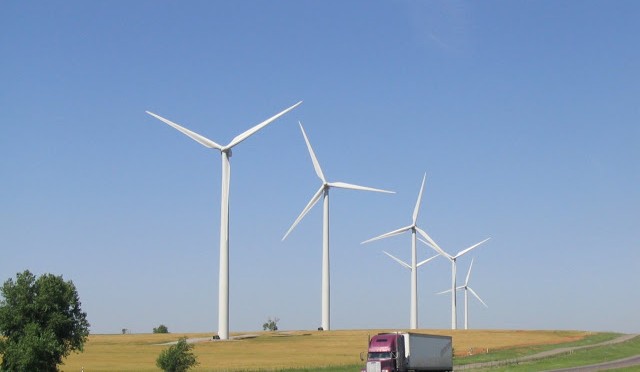Wind continues to sweep over the plains of Northwest Oklahoma, and more wind farms are being built to harness that energy.
In this quadrant of the state, there are numerous wind energy centers, including NextEra Energy’s Skeleton Creek Wind, Solar, and Battery Storage Project in Alfalfa, Garfield and Major counties; American Electric Power’s North Central Energy Facilities: Maverick Wind Project in Major, Garfield and Kingfisher counties and Sundance Wind Project in Major, Woods and Alfalfa counties; Invenergy’s Wagon Wheel Wind Project in Garfield, Kingfisher, Logan and Noble counties; and RENEW Energy’s wind turbine remanufacturing facility in Enid.
So what do the parent companies have to say about all those wind turbines taking up real estate in Northwest Oklahoma?
“Rural America doesn’t have a lot of industry or development bringing in that tax base,” said Bristi Cure, Ivenergy’s vice president of renewable development, who lives in a rural part of Texas. “We generate that tax revenue and make capital investments.”
‘Proud of what we’ve built’
Ivenergy built the Maverick and Sundance wind farms then sold them along with a third one in Blaine and Custer counties called Traverse — combined as North Central Energy Facilities — to American Electric Power (AEP). AEP is the parent of electric companies Public Service Co. of Oklahoma (PSO), which powers customers throughout the southern and eastern regions of Oklahoma, and Southwestern Electric Power Co. (SWEPCO), which powers customers throughout north central Louisiana and western Arkansas. Ivenergy now contracts with AEP to manage and maintain the North Central Energy Facilities.
In addition, Ivenergy will build another wind farm near Covington and Marshall called Wagon Wheel starting next year, and it is expected to be operational by the end of 2025. It will produce more wind energy than Maverick (287 megawatts) or Sundance (199 megawatts) combined, with an expected 600 megawatts. Comparatively, Skeleton Creek’s wind farm runs 250 megawatts.
“We’re proud of what we’ve built and excited we’re bringing another online,” Cure said.
Each wind energy company has stated they are: Creating hundreds of construction jobs plus more than 100 full-time positions, stimulating economic growth through property taxes that benefit schools and local services such as first responders, sustaining landowners with steady income and promoting clean energy sources.
NextEra Energy has invested more than $600 million in wind and solar power. Ivenergy invested more than $2 billion through the North Central Energy Facilities.
Renew Energy broke ground last October for its most recent, state-of-the-art facility, which will re-manufacture wind turbine drive trains and is said to be the largest facility in North America for these wind turbines. In fact, Renew’s COO Travis Harkins told the News & Eagle the 35,000-square-foot facility will be the first of its kind. He said it will have a capacity of up to 7 megawatts and be positioned to accommodate larger wind turbine platforms.
“With this facility, we’ll be able to support our customers with their initiatives to meet their goals and lower their carbon footprint with renewable energy,” Harkins said.
Environmental impact
According to the U.S. Department of Energy, wind energy, using massive turbines to generate electricity, is a renewable, domestic energy source that has a lesser environmental impact than burning fossil fuels.
Wind energy developers look at an area’s transmission availability, the environment and high wind demand when developing a new wind farm or energy center. Tricia Hale, NextEra Energy’s director of development in Oklahoma, told the News & Eagle last year the northwestern part of the state has the right mix of criteria for wind energy.
Wayne Greene, PSO’s spokesperson, concurred, saying Ivenergy was encouraged by the prospects back in 2017 of what Oklahoma had to offer. He said Oklahoma State University did an economic impact study prior and determined wind energy projects could pump millions of dollars into the local economy through taxes and lease payments while creating thousands of jobs.
Invenergy also has continued to closely work with the Department of Defense, Vance Air Force Base and Federal Aviation Administration to mitigate air concerns related to weather radars and flight patterns.
“We’ve worked it out where (wind farms) do not interfere with flying operations,” Cure said.
She said to the naysayers who criticize the long-term effects of wind turbines in rural America: “Their footprint is pretty small.”
Wind energy always will be there, and it will continue to be the cheapest energy option, Cure said. She added wind turbines are the easiest infrastructure to re-power and re-use.
“Re-powering is minimal and (wind turbines) can be replaced with better technology as it comes available,” Cure said.
At present, the Maverick wind farm has 103 wind turbines, Sundance has 72 and Skeleton Creek has 90.
And what about the turbine that mysteriously collapsed last summer in the Maverick wind farm southeast of Ames?
“It has been removed. We expect to have its replacement in place in March,” Greene said.
Ruth Ann Replogle, enidnews.com


